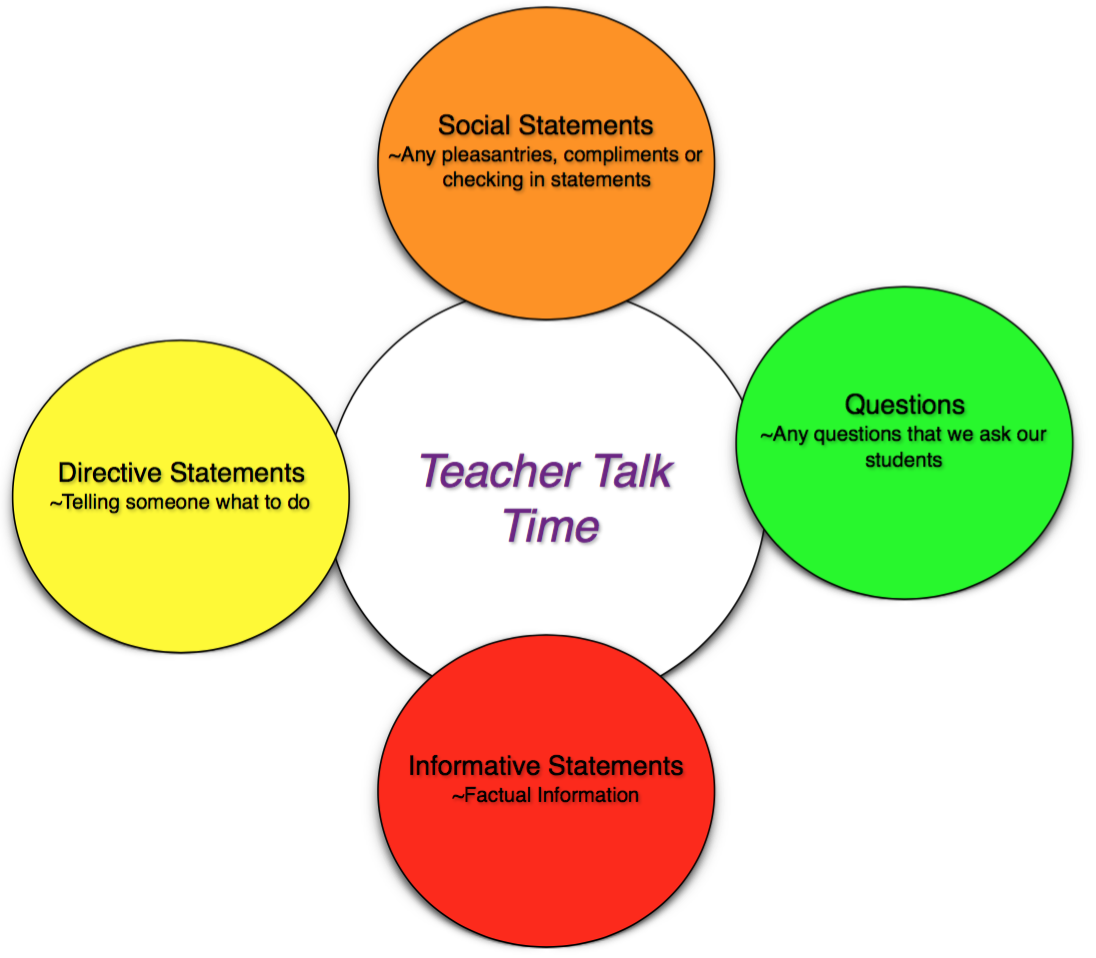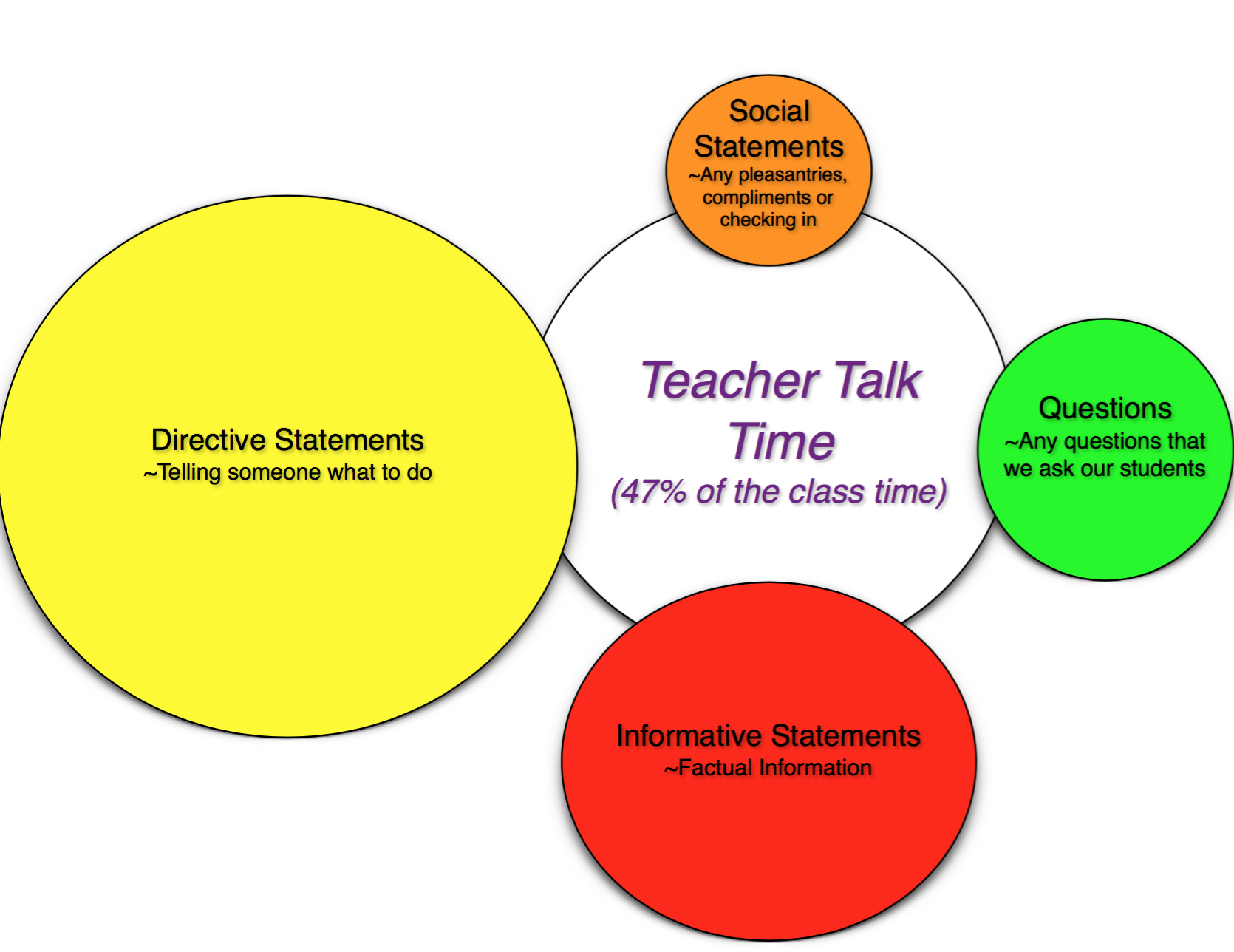|
My friend, Marina Gijzen, wrote a great blog post a few months ago that focuses on the need to become more aware of how we tend to communicate with our students. The evidence related to talk time generally shows that we, as teachers, talk too long when instructing our students regardless of the subject area. Simply using a stopwatch to record the amount of time we speak in class might be one way to measure our talk time, but this strategy will not provide us with enough data to truly reflect upon how we are communicating with our students. Marina’s post challenges teachers to think about the type of language that they use by keeping data that will provide us with specific information related to how we communicate. There are 4 key ways in which we communicate with our students: directive statements, social statements, questions, and informational statements. Although all of these areas are essential at different times in our teaching, the purpose of this post is to get you to reflect upon the type of language that you use with your students and to consider ways of using data to provide you with important information about your own teaching. Marina suggests that an effective way that we become more aware of our own language when instructing our students is to try to keep track by using check marks for each category. This can be achieved by ticking off what box our language might fall into using 4 different pieces of masking tape stuck to our arm. Sure, the masking tape might seem clunky and awkward, but will be an important cue to remind us of why it's there and to use it. I've inserted 2 pictures below to show you what this might look like. The picture on the left is taken directly from Marina's blog post and the picture on the right is the arm of my wife, Neila Steele, who has tried the strategy out several times. It'll be impossible to record ticks for every single thing that we say when teaching, but just paying closer attention to our language can help us to become more aware of any general trends or patterns. Neila found that she was using many directive statements with her students and even realized that she needed to be more aware of the tone that she used when speaking to her students. As a result, she created a 5th piece of tape which focused on tone to remind her to be more aware of the tone that she used when communicating with her students. Another Useful Strategy You might also try asking an administrator or colleague to come in to observe you when you are teaching and to provide you with data related to these 4 areas. They don't even necessarily have to check boxes but can just listen and record in what ways you are communicating to your students. When looking at the data later, you can classify and categorize your language into directive statements, questions, social statements, and informational statements. They might also use a stopwatch to record the actual time (whole group discussion) that you spoke to your students adding another element to the data provided to you. What to do with this data? This data can be used in multiple ways to inform our teaching. Although directive statements are a critical part of our teaching, are there other ways to communicate what we feel is important to say to our students? Perhaps we find ourselves asking too many directive statements ("Stop that!", "Go over there!", "Focus on your own work!", "Be quiet!", etc) and want to challenge ourselves to flip directives into more empowering ways to communicate with our students. We might find that we are not actually checking in enough with our students and make it a goal to do this more often in order to build stronger relationships with those who we teach. We might notice that we are asking questions, but that this could be an area that we work on further developing. Whatever it is, by breaking down the ways in which we communicate with our students, we provide ourselves with data that can inform next steps in our teaching in an effort to refine our instruction. What might a breakdown of the way you communicate with your students look like? The example below shows the amount of teacher talk time in general. It also shows that directive statements were most common with social statements being least common. So, my challenge to you is to give this a try at least once. Perhaps you will learn something about yourself and your teaching that you might have been unaware of had you not given it a shot. Teaching is a tough job even on the very best of days. Adding things such as this to our plate might seem impossible due to the heavy demands that our placed upon us, but giving new things a try can truly help us to breathe new life into our teaching and to stay motivated. Happy teaching folks. Thanks for reading.
2 Comments
Barbara Connolly
7/12/2017 05:46:07 am
Great piece. How often we default to a patter which often loses real communication. Then we wonder why those we work with don't get what we say. Also, how much is what we MEAN buried under a sea of verbiage? Words are hugely powerful. Combined with tone and disposition they become more powerful still and need to be used carefully and wisely. It strikes me that an interesting/experimental development of your thoughts above could be silent teaching? It could be really interesting to see how effective communication can be then?
Reply
12/18/2017 07:24:42 pm
Kitchen renovating falls among the most mainstream home change ventures mortgage holders attempt to spruce up their space. Regardless of whether to meet the developing needs of the family and appreciate the progressions for quite a while or prepare the house available to be purchased, this kind of task has demonstrated exceptionally advantageous. Being the core of your New York home and among the most frequented territories, redesigns minor or major would without a doubt bring included interest, solace, and usefulness; making every single time spent pleasurable.
Reply
Leave a Reply. |
AuthorKAUST Faculty, Pedagogical Coach. Presenter & Workshop Leader.IB Educator. #RunYourLife podcast host. Archives
September 2022
|
- Welcome
- All Things Teaching and Learning
- The Aligned Leader Blog
- Consulting and Coaching Opportunities
- My TED X Talk
- My Leadership Blog
- Run Your Life Podcast Series
- How PYP PE with Andy Has Helped Others
- Good Teaching is L.I.F.E
- The Sportfolio
- Example Assessment Tasks
- PYP Attitude Posters (printable)
- Publications




 RSS Feed
RSS Feed
